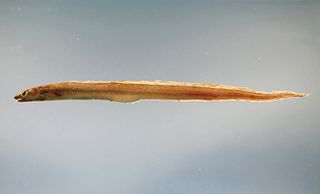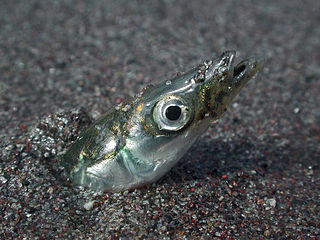
Moray eels, or Muraenidae, are a family of eels whose members are found worldwide. There are approximately 200 species in 15 genera which are almost exclusively marine, but several species are regularly seen in brackish water, and a few are found in fresh water.

Conger is a genus of marine congrid eels. It includes some of the largest types of eels, ranging up to 2 m (6 ft) or more in length, in the case of the European conger. Large congers have often been observed by divers during the day in parts of the Mediterranean Sea, and both European and American congers are sometimes caught by fishermen along the European and North American Atlantic coasts.

Ophichthidae is a family of fish in the order Anguilliformes, commonly known as the snake eels. The term "Ophichthidae" comes from Greek ophis ("serpent") and ichthys ("fish"). Snake eels are also burrowing eels, they are named for their physical appearance, they have long, cylindrical, snake-like bodies. This family is found worldwide in tropical to warm temperate waters. They inhabit a wide range of habitats, from coastal shallows and even rivers, to depths below 800 m (2,600 ft). Most species are bottom dwellers, hiding in mud or sand to capture their prey of crustaceans and small fish, but some are pelagic.
The Anguillidae are a family of ray-finned fish that contains the freshwater eels. Eighteen of the 19 extant species and six subspecies in this family are in the genus Anguilla. They are elongated fish with snake-like bodies, their long dorsal, caudal and anal fins forming a continuous fringe. They are catadromous fish, spending their adult lives in fresh water, but migrating to the ocean to spawn. Eels are an important food fish and some species are now farm-raised, but not bred in captivity. Many populations in the wild are now threatened, and Seafood Watch recommend consumers avoid eating anguillid eels.

A sand lance or sandlance is a fish belonging to the family Ammodytidae. Several species of sand lances are commonly known as "sand eels", though they are not related to true eels. Another variant name is launce, and all names of the fish are references to its slender body and pointed snout. The family name means "sand burrower", which describes the sand lance's habit of burrowing into sand to avoid tidal currents.

Nettastomatidae, the duckbill eels or witch eels are a family of eels. The name is from Greek netta meaning "duck" and stoma meaning "mouth".

Gymnothorax is a genus of fish in the family Muraenidae found in Atlantic, Indian and Pacific Ocean. With more than 120 species, it the most speciose genus of moray eels.
Mastacembelus is a genus of many species of spiny eel fish from the family Mastacembelidae. They are native to Africa and Asia. Most are found in rivers and associated systems, but there are also species in other freshwater habitats and a particularly rich radiation is found in the Lake Tanganyika basin with 15 species. A few species can even occur in brackish water.

Eels are ray-finned fish belonging to the order Anguilliformes, which consists of eight suborders, 19 families, 111 genera, and about 800 species. Eels undergo considerable development from the early larval stage to the eventual adult stage, and most are predators.

Serrivomer is a genus of deep-sea eel in the family Serrivomeridae. It contains ten described species. Member species are distributed widely, being found in the Atlantic, Pacific and Indian Oceans. The smallest species in this genus is Serrivomer jesperseni, which has a maximum length of 40.6 cm; the largest species in this genus is Serrivomer beanii with a maximum length of 78 cm. Most members reach a maximum length of 60–70 cm,

Moringua is a genus of eels of the family Moringuidae that occur in shallow tropical and subtropical waters. It contains these described species:
Bathycongrus is a genus of eels in the family Congridae.

Pisodonophis is a genus of eels in the snake eel family Ophichthidae. It currently contains the following species:

Protanguilla palau is a species of eel, the only species in the genus Protanguilla, which is in turn the only genus in its family, Protanguillidae. Individuals were found swimming in March 2010 in a deep underwater cave in a fringing reef off the coast of Palau.

Juvenile fish go through various stages between birth and adulthood. They start as eggs which hatch into larvae. The larvae are not able to feed themselves, and carry a yolk-sac which provides their nutrition. Before the yolk-sac completely disappears, the tiny fish must become capable of feeding themselves. When they have developed to the point where they are capable of feeding themselves, the fish are called fry. When, in addition, they have developed scales and working fins, the transition to a juvenile fish is complete and it is called a fingerling. Fingerlings are typically about the size of fingers. The juvenile stage lasts until the fish is fully grown, sexually mature and interacting with other adult fish.
Panturichthys fowleri is an eel in the family Heterenchelyidae. It was described by Adam Ben-Tuvia in 1953, originally under the genus Lophenchelys. It is a subtropical, marine eel which is known from a single specimen collected from Israel, in the Mediterranean Sea. The holotype specimen was discovered dwelling at a depth range of 27–55 metres.
Panturichthys isognathus is an eel in the family Heterenchelyidae. It was described by Max Poll in 1953. It is a tropical, marine eel which is known from the Gulf of Guinea in the eastern Atlantic Ocean, where it predominates south of the equator. It typically dwells at a depth range of 40–150 metres. Males can reach a maximum total length of 32.5 centimetres.
The slender shortfaced eel is an eel in the family Heterenchelyidae. It was described by Ernst Ehrenbaum in 1915, originally under the genus Heterenchelys. It is a tropical, marine eel which is known from Benin to Angola in the Gulf of Guinea, in the eastern Atlantic Ocean. Males can reach a maximum total length of 149 centimetres.
The Mauritanian shortface eel is an eel in the family Heterenchelyidae. It was described by Jacques Pellegrin in 1913. It is a tropical, marine eel which is known from the eastern Atlantic Ocean, where it is distributed from Morocco to Guinea. It typically dwells at a depth range of 30–1000 metres, habituating muddy substrates on the African continental shelf. Males can reach a maximum total length of 84 centimetres.

Electrophorus is a genus of Neotropical freshwater fish in the family Gymnotidae, commonly called electric eels. They are known for their ability to stun their prey by generating electricity. Despite their name, electric eels are not closely related to the true eels (Anguilliformes) but are members of the neotropical knifefish order (Gymnotiformes), which is more closely related to the catfish.












